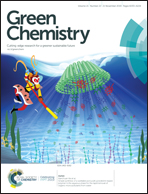The sustainable room temperature conversion of p-xylene to terephthalic acid using ozone and UV irradiation†
Abstract
Current industrial processes utilize Co/Mn bromides as catalysts to catalyze the oxidative conversion of para-xylene to terephthalic acid (TA) in acetic acid at high temperatures (>200 °C, air, 15–30 atm.). The decomposition of metallo-catalysts and solvents at high temperatures as well as a subsequent hydropurification process releases thousands of millions of tons of wastewater, global warming gas (CO2) and ozone depleting gas (CH3Br) into the global environment per year, causing global warming, ozone depletion, dramatic climate change, huge economic losses, and many other environmental problems. Herein, we report an alternative sustainable process with low energy demand for the room temperature oxidative conversion of p-xylene to terephthalic acid, with 96% TA yield and 98% selectivity, via ozone treatment and concurrent UV irradiation and without the generation and release of greenhouse gas (CO2), ozone depleting gas (CH3Br), and wastewater, or the need for a high energy-demand hydropurification process. The reaction mechanism involves the singlet O(1D)- and hydroxyl radical-mediated selective C–H functionalization of p-xylene.



 Please wait while we load your content...
Please wait while we load your content...